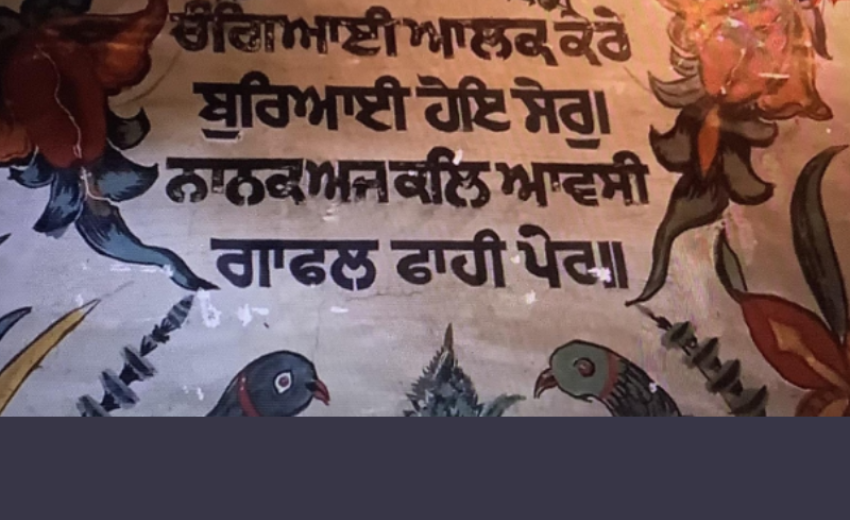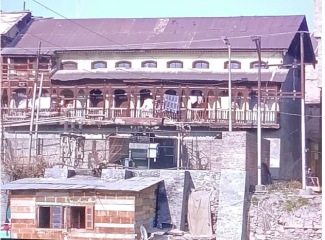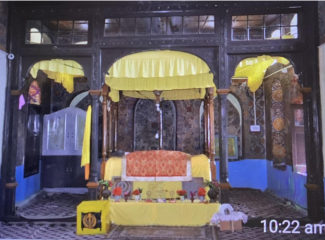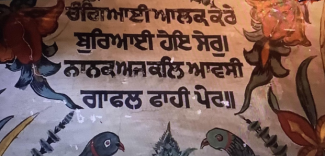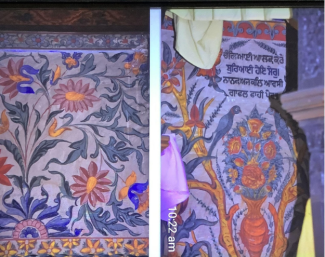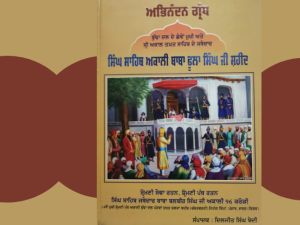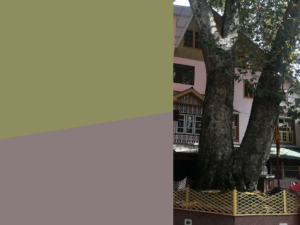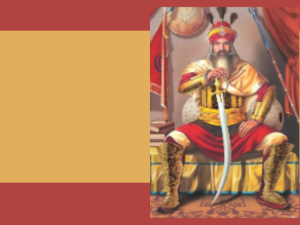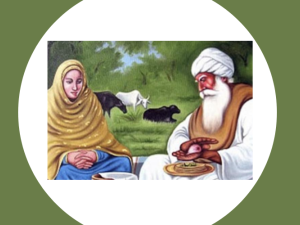The Valley of Kashmir, nestled between India and Pakistan, is often hailed as the crown of the Indian subcontinent. Renowned for its breathtaking beauty, scholars, kings, and historians have lauded Kashmir through the ages. The spring season reveals a kaleidoscope of pastel hues, and summers blanket the valley in lush greenery, including vibrant rice fields along the Jhelum River. (Outer view of Gurdwara Maharaj Gunj,Srinagar )
Autumn graces the region with the captivating sight of Chinar leaves displaying a myriad of colors, coinciding with the fruit-bearing season. Winters, marked by cool temperatures, are celebrated for winter sports, set against a backdrop of towering poplars, verdant willows, and majestic Chinars that adorn the valley. (Internal view of Gurdwara)
The Zaina Kadal, housing the tomb of Kashmir's revered king Zain-ul-abadin, lies beneath the fourth bridge, while the MaharajGanj on the right bank showcases the city's art wares. The Nawa Kadal, below the sixth bridge, hosts a temple by Pandit Ramju, and the Safr Kadal, known as the bridge of departure, concludes the series. These bridges, marked by their cost-effectiveness and picturesque design, owe their stability to skeleton piers that offer minimal resistance to floodwaters. Despite the heavy floods of 1893 affecting six of the seven bridges, their enduring resilience suggests the effectiveness of this construction approach. Notably, the Habba Kadal and Zaina Kadal once featured rows of shops on their structures.
The Kashmir valley has witnessed visits from Sikh Gurus, including Guru Nanak Dev in 1517, Guru Hargobind in 1620, and Guru Har Rai around 1660. Guru Arjan Dev dispatched missionaries to Jammu and Kashmir, traversing through Poonch, culminating in their arrival in the Kashmir region. Notably, Bhai Madho Sodhi emerged as a prominent figure among these emissaries, receiving a specific mandate from Guru Ji for the propagation of Sikh Dharam Parchar. Bhai Madho Sodhi diligently traversed various locales within the valley, adeptly persuading numerous individuals to embrace Sikhism. It is conceivable that Madho Sodhi may have utilized this Dharamshala as a center for disseminating Sikh values, given the concentration of Gurmat adherents in the valley. Bhai Madho Sodhi stayed almost a year and disseminated Sikh values in every pocket of Kashmir.
( wall paintings in Gurdwara)
This inconspicuous gem, nestled in a narrow alley, showcases a blend of historical importance and architectural subtlety. Gurdwara Maharaj Ganj dating back to the 17th Century. The shrine's origin as a Dharamshala underscores its early role as a congregational gathering place for Sikh worship. Initially recognized as one of the ancient Dharamshala's for Sikhs, it eventually gained prominence as Gurdwara MaharajGanj. Gurdwara situated in the MaharajGanj area of Srinagar, holds a unique charm as the oldest Sikh shrine in Kashmir.
The Gurdwara, initially known as Gurdwara MaharajGanj, has stood the test of time, witnessing the cultural and historical shifts in the region. The floral embellishments on the Gurdwara's walls reflect the decorative practices prevalent during the reign of Sikh Maharaja Ranjit Singh. Motifs from Gurdwaras, including the Golden Temple, have inspired artistry, showcasing a rich cultural tapestry. S. Hari Singh Nalwa as Governor of Kashmir built the forts of Uri and Muzaffarabad and established the settlements of Shaheed Ganj and Guru Bazar in Srinagar where Nihangs and Akalis settled permanently in Shaheed Ganj and Guru Bazar was inhabited by Sikh Granthis and Hindu Sadhus.
This area MaharajGanj is characterized by the residence of numerous Punjabi shopkeepers and merchants and was formerly home to the elite houses of Kashmir. The extensive damage caused by a fire in 1892, estimated at 20 Lakh rupees, resulted in the destruction of 500 houses, mosques, temples, and notably, Gurdwara Maharajganj. Subsequently, during the Dogra Partap Singh regime, efforts were made to reconstruct the Gurdwara building, restoring its significance in Sikh heritage within the region. The edifice Enveloped by the Jhelum River on its occidental flank and abutting a commercial-residential nexus on the opposing aspect, this architectural construct is reported by local informants to bear an antiquity of approximately seven decades. Singularly representing the Sikh community's religious enclave along the riverine precincts within the urban nucleus, this gurdwara assumes eminence. Erected in the linear paradigm with a two-tier configuration and orientation along the cardinal axis, the structure adheres to the prevalent Colonial Style of the early 20th Century. The lower tier functions primarily as a repository, while the upper tier serves as a sanctified assembly space. The interior embellishments manifest through papier-mâché adorned ceilings and intricately painted naqqashi motifs upon the walls. A conspicuous element of the façade is the dominance of a segmental arched arcade. The load-bearing brick masonry of the walls is a noteworthy construction attribute, with the upper tier.( Flora and Fauna wall paintings)
It stands on the banks of the Jhelum River, contributing to the picturesque Venice of the East scenery. This Gurdwara was constructed during Sikh rule in Kashmir. Later on, it was renovated in 1920s colonial style, the Gurdwara's unassuming exterior contrasted with its ornate interior. Wooden arched windows with colored glass face the riverfront, providing a serene backdrop. Notably, it boasts a rare papier mâché ceiling, a distinctive feature in Srinagar's Sikh shrines. The ceiling, created by master papier mâché artisan Shabir Hussain Jan, showcases intricate geometric spheres, saffron-clad roses, and various flowers and creepers. The motifs draw inspiration from traditional papier mâché patterns rather than shawls, emphasizing the artistic lineage.
Gurdwara MaharajGanj is renowned for its Basant Panchami celebrations in early March, adding vibrancy to the local Sikh community. The preparation of Karah Prasad during this occasion further enhances the cultural and religious significance of the Gurdwara. In Maharaj Gunj Area, surrounding the Gurdwara are a Hindu temple, a mosque, and a market square established by Maharaja Ranbir Singh. Despite the market's current dilapidated state, the area retains its cultural richness with around 1,000 shops, including those selling copperware and spices.
Gurdwara Maharaj Ganj stands not only as a place of worship but also as a testament to the enduring cultural and religious heritage of Sikhism in the Kashmir Valley. Its architectural and artistic elements weave a narrative that connects the past with the present, making it a significant landmark in Srinagar. (Sources. Gazetteer of India, The valley of Kashmir,Sher-I-Kashmir, Directory of Traditional Buildings Crafts of India,The Sikhs in Jammu and Kashmir, Natural Calamities of Jammu and Kashmir. The author thanks R S Raina formerly Director Doordarshan and Prabhjot Singh of Versa Chanel for inputs and images)

